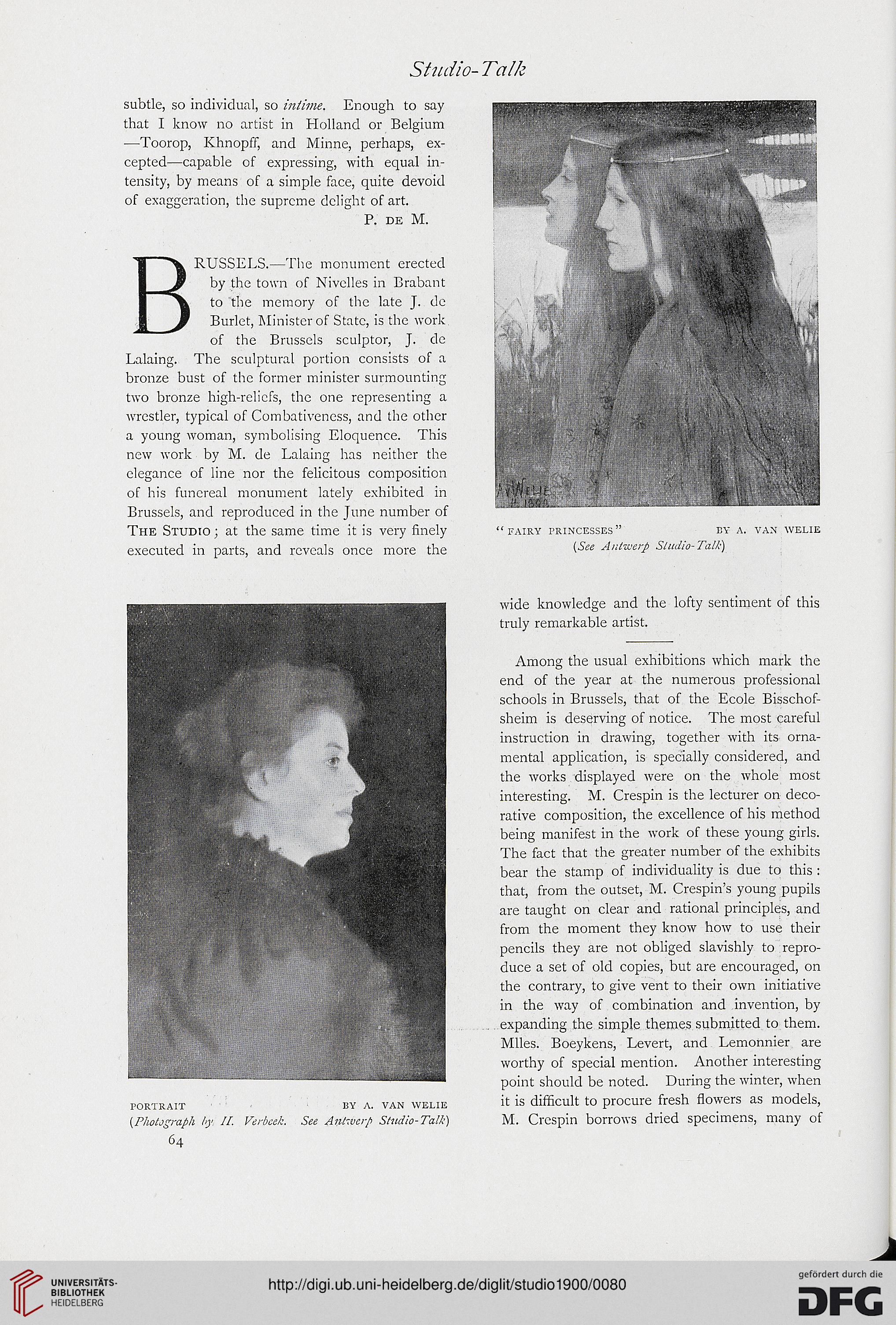Studio-Talk
subtle, so individual, so intime. Enough to say
that I know no artist in Holland or Belgium
—Toorop, Khnopff, and Minne, perhaps, ex-
cepted—capable of expressing, with equal in-
tensity, by means of a simple face, quite devoid
of exaggeration, the supreme delight of art.
P. de M.
BRUSSELS.—The monument erected
by the town of Nivelles in Brabant
to the memory of the late J. de
Burlet, Minister of State, is the work
of the Brussels sculptor, J. dc
Lalaing. The sculptural portion consists of a
bronze bust of the former minister surmounting
two bronze high-reliefs, the one representing a
wrestler, typical of Combativencss, and the other
a young woman, symbolising Eloquence. This
new work by M. de Lalaing has neither the
elegance of line nor the felicitous composition
of his funereal monument lately exhibited in
Brussels, and reproduced in the June number of
The Studio ; at the same time it is very finely
executed in parts, and reveals once more the
PORTRAIT BY A. VAN WELIE
[Photograph by. II. Vcrbcek. See Antwerp Sttidio-Talk)
64
"FAIRY PRINCESSES" BY A. VAN WELIE
(See Antwerp Studio- Y'a/k)
wide knowledge and the lofty sentiment of this
truly remarkable artist.
Among the usual exhibitions which mark the
end of the year at the numerous professional
schools in Brussels, that of the Ecole Bisschof-
sheim is deserving of notice. The most careful
instruction in drawing, together with its orna-
mental application, is specially considered, and
the works displayed were on the whole most
interesting. M. Crespin is the lecturer on deco-
rative composition, the excellence of his method
being manifest in the work of these young girls.
The fact that the greater number of the exhibits
bear the stamp of individuality is due to this :
that, from the outset, M. Crespin's young pupils
are taught on clear and rational principles, and
from the moment they know how to use their
pencils they are not obliged slavishly to repro-
duce a set of old copies, but are encouraged, on
the contrary, to give vent to their own initiative
in the way of combination and invention, by
expanding the simple themes submitted to them.
Miles. Boeykens, Levert, and Lemonnier are
worthy of special mention. Another interesting
point should be noted. During the winter, when
it is difficult to procure fresh flowers as models,
M. Crespin borrows dried specimens, many of
subtle, so individual, so intime. Enough to say
that I know no artist in Holland or Belgium
—Toorop, Khnopff, and Minne, perhaps, ex-
cepted—capable of expressing, with equal in-
tensity, by means of a simple face, quite devoid
of exaggeration, the supreme delight of art.
P. de M.
BRUSSELS.—The monument erected
by the town of Nivelles in Brabant
to the memory of the late J. de
Burlet, Minister of State, is the work
of the Brussels sculptor, J. dc
Lalaing. The sculptural portion consists of a
bronze bust of the former minister surmounting
two bronze high-reliefs, the one representing a
wrestler, typical of Combativencss, and the other
a young woman, symbolising Eloquence. This
new work by M. de Lalaing has neither the
elegance of line nor the felicitous composition
of his funereal monument lately exhibited in
Brussels, and reproduced in the June number of
The Studio ; at the same time it is very finely
executed in parts, and reveals once more the
PORTRAIT BY A. VAN WELIE
[Photograph by. II. Vcrbcek. See Antwerp Sttidio-Talk)
64
"FAIRY PRINCESSES" BY A. VAN WELIE
(See Antwerp Studio- Y'a/k)
wide knowledge and the lofty sentiment of this
truly remarkable artist.
Among the usual exhibitions which mark the
end of the year at the numerous professional
schools in Brussels, that of the Ecole Bisschof-
sheim is deserving of notice. The most careful
instruction in drawing, together with its orna-
mental application, is specially considered, and
the works displayed were on the whole most
interesting. M. Crespin is the lecturer on deco-
rative composition, the excellence of his method
being manifest in the work of these young girls.
The fact that the greater number of the exhibits
bear the stamp of individuality is due to this :
that, from the outset, M. Crespin's young pupils
are taught on clear and rational principles, and
from the moment they know how to use their
pencils they are not obliged slavishly to repro-
duce a set of old copies, but are encouraged, on
the contrary, to give vent to their own initiative
in the way of combination and invention, by
expanding the simple themes submitted to them.
Miles. Boeykens, Levert, and Lemonnier are
worthy of special mention. Another interesting
point should be noted. During the winter, when
it is difficult to procure fresh flowers as models,
M. Crespin borrows dried specimens, many of




